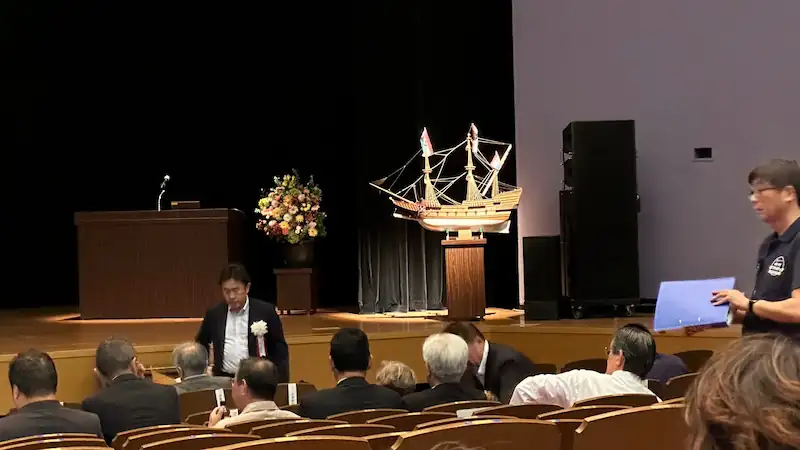- A Rainy Day in Ito: The Tale of William Adams and “Shōgun”
- A Rainy Venue and the Speaker’s Profile
- Key Takeaways
- 1. The Colossal “Carracks” of the 16th–17th Centuries
- 2. Why Adams’ ~80-Ton Ship Was Still Revolutionary
- 3. The Definition of “Samurai” Changes with Time
- 4. The Myth and Literature of the “Blue-Eyed Samurai”
- 5. How the Novel “Shōgun” Was Born
- 6. The 1980 NBC Television Adaptation
- 7. Choosing Ajiro and Historical Accuracy in Bathing and Landing Scenes
- A “Bridge” to Ito, 400 Years Ago
- Books by the Speaker
A Rainy Day in Ito: The Tale of William Adams and “Shōgun”
August 10, 2025 – Notes from a Lecture in Ito City
This article is based on the lecture “The TV Drama ‘Shōgun’ and the History Linking William Adams and Ito” (Speaker: Professor Frédéric Cléans, Deputy Director of the International Research Center for Japanese Studies), held in Ito City on August 10, 2025, interwoven with my own experiences and impressions.

A Rainy Venue and the Speaker’s Profile
Despite the bad weather, the venue was packed. Professor Frédéric Cléans, originally from Belgium and now living in Japan, is renowned for his role as a historical advisor for the TV drama “Shōgun.” I have already introduced William Adams’ life and related locations on my site Following the Shogun, but this lecture brought me several new insights.

Key Takeaways
1. The Colossal “Carracks” of the 16th–17th Centuries
The Portuguese regularly sailed to Japan aboard massive carracks (naus) of around 1,500 tons, effectively monopolizing trade. The largest examples reached an impressive 40–50 meters in length and 12–15 meters in width (varying by design and era)—an extraordinary scale for the time.
2. Why Adams’ ~80-Ton Ship Was Still Revolutionary
The Western-style sailing ship built in Ito under Adams’ guidance was only about 80 tons, but its Western design made it capable of long-distance voyages. This innovation helped lay the groundwork for the Red Seal Ship trade, expanding Japan’s maritime commerce.
3. The Definition of “Samurai” Changes with Time
During the Sengoku period, samurai referred broadly to “those who served a military household.” However, Western visitors in the late Edo period understood it as “professional soldiers who wore swords.” This Westernized image was re-imported into Japan and remains common today—a fascinating example of how words evolve over time.
4. The Myth and Literature of the “Blue-Eyed Samurai”
The fact that an Englishman became a samurai in the early Edo period gained a romantic aura in 19th-century Europe and America, inspiring many novels. Among the most famous is James Clavell’s epic “Shōgun” (1975).
5. How the Novel “Shōgun” Was Born
Clavell reportedly noticed a single sentence in his daughter’s textbook in London: “In 1600, an Englishman went to Japan and became a samurai.” This sparked years of research into Japanese history—three to four years—culminating in his novel.
6. The 1980 NBC Television Adaptation
In 1980, NBC adapted the story into a drama starring Toshirō Mifune and Yōko Shimada, leaving a lasting impression of Japanese culture on overseas audiences.
7. Choosing Ajiro and Historical Accuracy in Bathing and Landing Scenes
- In the novel, the shipwreck site was the fictional “Anjiro.” The professor suggested changing it to the real Ajiro, as it resonated with the historical fact that a ship was built in Ito. This gave the story symbolic depth.
- A script scene where a daimyo’s wife bathes naked in front of a foreign navigator was deemed historically implausible and changed to a hot spring scene.
- Since piers were uncommon in Japan at the time, landing from a large ship would have involved transferring to small boats. The pier idea was dropped for historical accuracy.
A “Bridge” to Ito, 400 Years Ago
Four centuries ago, an Englishman built a Western-style sailing ship in Ito. It was not only a vessel of wood and iron, but also a bridge—connecting Western knowledge and technology with human hearts. The lecture brought to life the connections between history, modern visual storytelling, and local cultural outreach.
Books by the Speaker
“William Adams: The Man Loved by Ieyasu – Miura Anjin” (Chikuma Shinsho)
The definitive account of Adams’ life and role, based on primary sources and meticulous research. It contains many key points overlapping with this lecture.
“The Sengoku Samurai’s View of Life and Death” (Gentosha Shinsho)
A deep dive into the values of the Sengoku to early Edo periods, covering seppuku, loyalty, and the role of women. An insightful read for understanding the debates surrounding “Shōgun.”
*Ship sizes and figures are representative examples; they vary by design, place of construction, and era.

comment